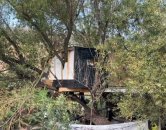Three Canadian teams hope to make plush passenger for next NASA moon mission

The next time humans fly to the moon, there will be a Canadian among the crew. Astronaut Jeremy Hansen has been chosen to fly on the Artemis II mission, slated for liftoff as early as next April.
But today, NASA announced the possible addition of another Canadian on the flight. Sort of. The space agency ran a contest this year called the NASA Artemis II ZGI Design Challenge , and three Canadian teams are among the finalists.
“Artemis II ZGI Design Challenge” is a bit of a mouthful, so it’s also known as a Moon Mascot. Basically, spacecraft often fly with a small stuffed animal or or toy aboard. When the flight reaches the stage of weightlessness, this little passenger starts to float around the capsule, acting as a zero-gravity indicator, or ZGI.
The tradition dates back to the earliest days of spaceflight — cosmonauts, the spacefarers of the Soviet Union , were very keen on the idea — and continues to this day. The Artemis I flight of 2022 did not have a human crew, but it did carry a little plush Snoopy, clad in a miniature spacesuit.
Artemis II will be a 10-day mission with a crew of five: NASA astronauts Reid Wiseman, Victor Glover and Christina Koch, Canadian Space Agency astronaut Hansen — and the ZGI.
The agency received more than 2,600 design submissions from around the globe, and whittled the list down to 25 finalists, each of whom will receive either a cash prize of US$1,225 or an Artemis prize package, depending on their age. Entries were accepted from several grade-school categories plus one for adults.
Among the finalists were three with a distinctly Canadian flavour.
From the K-to-5 classroom category, students at Royal School in Winnipeg delivered a design for Luna the Space Polar Bear. The bear wears a spacesuit and an astronaut helmet, and the design as inspired by how polar bears adapt to extreme cold environments, similarly to how spacesuits protect astronauts from the extreme environment of space.
Students from Oakville Trafalgar High School in Oakville, Ont., created a design for Lepus the Moon Rabbit. This lunar bunny features markings that look like the Moon’s craters, while its oversized ears are decorated with constellations. It holds a small Earth “balloon” that symbolizes how precious Earth is in the vastness of space.
The third Canadian finalist was Caroline Goyer-Desrosiers of St. Eustache, Que. A project management business partner at Airbus, she designed a flying squirrel with a space helmet on its head and a moon logo on its chest.
They face some strong competition from others including Rise, a smiling moon wearing an Earth-patterned baseball cap, and inspired by the Earthrise picture taken from Apollo 8 in 1968; Artemis, a plush depiction of the Greek goddess after whom the program is named; and Art and The Giant, which features an astronaut perched on the shoulder of a mythological giant named Orion, which is also the name of the capsule in which the astronauts will fly.
“What better way to fly a mission around the moon than to invite the public inside NASA’s Orion spacecraft with us and ask for help in designing our zero gravity indicator?” said Wiseman, the commander of Artemis II, when the competition was announced. “The indicator will float alongside Victor, Christina, Jeremy and me as we go around the far side of the moon, and remind us of all of you back on Earth.”
NASA has not yet revealed when the winning design will be chosen, but with the launch of Artemis II scheduled for as soon as eight months from now it will need to decide soon which one of the finalists has the right stuff. Or the right stuffing.
Our website is the place for the latest breaking news, exclusive scoops, longreads and provocative commentary. Please bookmark nationalpost.com and sign up for our daily newsletter, Posted, here.



Comments
Be the first to comment